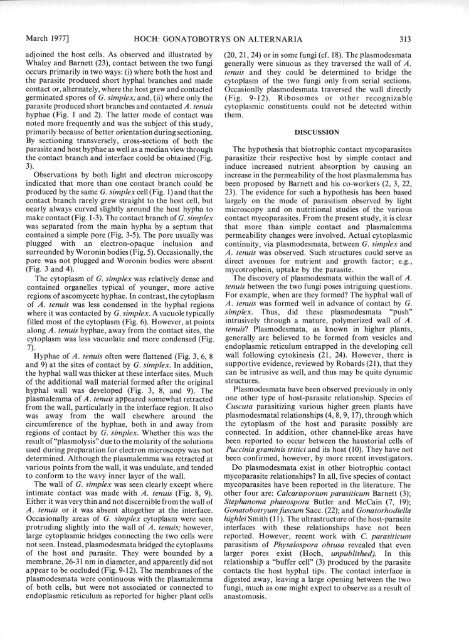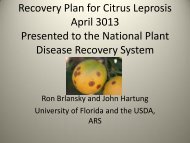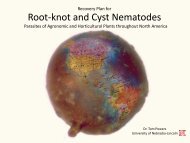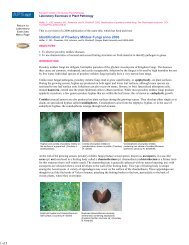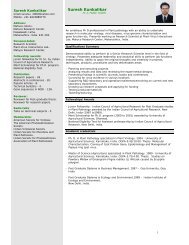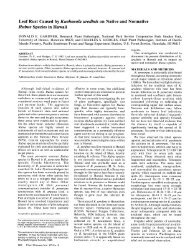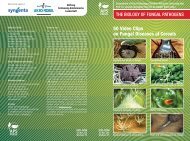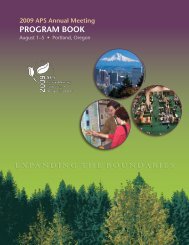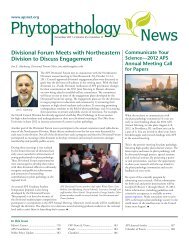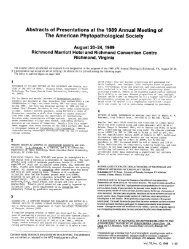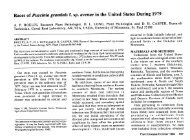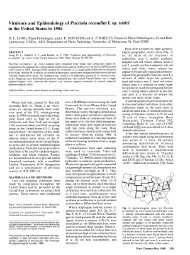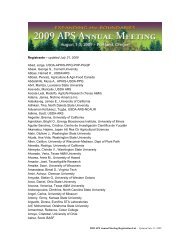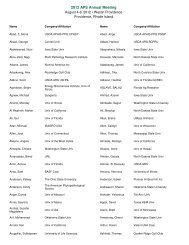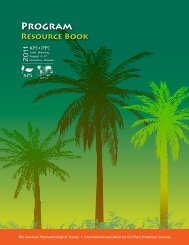Mycoparasitic Relationships: Gonatobotrys simplex Parasitic on ...
Mycoparasitic Relationships: Gonatobotrys simplex Parasitic on ...
Mycoparasitic Relationships: Gonatobotrys simplex Parasitic on ...
Create successful ePaper yourself
Turn your PDF publications into a flip-book with our unique Google optimized e-Paper software.
March 1977] HOCH: GONATOBOTRYS ON ALTERNARIA 313<br />
adjoined the host cells. As observed and illustrated by (20, 21, 24) or in some fungi (cf. 18). The plasmodesmata<br />
Whaley and Barnett (23), c<strong>on</strong>tact between the two fungi generally were sinuous as they traversed the wall of A.<br />
occurs primarily in two ways: (i) where both the host and tenuis and they could be determined to bridge the<br />
the parasite produced short hyphal branches and made cytoplasm of the two fungi <strong>on</strong>ly from serial secti<strong>on</strong>s.<br />
c<strong>on</strong>tact or, alternately, where the host grew and c<strong>on</strong>tacted Occasi<strong>on</strong>lly plasmodesmata traversed the wall directly<br />
germinated spores of G. <str<strong>on</strong>g>simplex</str<strong>on</strong>g>; and, (ii) where <strong>on</strong>ly the (Fig. 9-12). Ribosomes or other recognizable<br />
parasite produced short branches and c<strong>on</strong>tacted A. tenuis cytoplasmic c<strong>on</strong>stituents could not be detected within<br />
hyphae (Fig. 1 and 2). The latter mode of c<strong>on</strong>tact was them.<br />
noted more frequently and was the subject of this study,<br />
primarily because of better orientati<strong>on</strong> during secti<strong>on</strong>ing.<br />
DISCUSSION<br />
By secti<strong>on</strong>ing transversely, cross-secti<strong>on</strong>s of both the<br />
parasite and host hyphae as well as a median view through The hypothesis that biotrophic c<strong>on</strong>tact mycoparasites<br />
the c<strong>on</strong>tact branch and interface could be obtained (Fig. parasitize their respective host by simple c<strong>on</strong>tact and<br />
3). induce increased nutrient absorpti<strong>on</strong> by causing an<br />
Observati<strong>on</strong>s by both light and electr<strong>on</strong> microscopy increase in the permeability of the host plasmalemma has<br />
indicated that more than <strong>on</strong>e c<strong>on</strong>tact branch could be been proposed by Barnett and his co-workers (2, 3, 22,<br />
produced by the same G. <str<strong>on</strong>g>simplex</str<strong>on</strong>g> cell (Fig. 1) and that the 23). The evidence for such a hypothesis has been based<br />
c<strong>on</strong>tact branch rarely grew straight to the host cell, but largely <strong>on</strong> the mode of parasitism observed by light<br />
nearly always curved slightly around the host hypha to microscopy and <strong>on</strong> nutriti<strong>on</strong>al studies of the various<br />
make c<strong>on</strong>tact (Fig. 1-3). The c<strong>on</strong>tact branch of G. <str<strong>on</strong>g>simplex</str<strong>on</strong>g> c<strong>on</strong>tact mycoparasites. From the present study, it is clear<br />
was separated from the main hypha by a septum that that more than simple c<strong>on</strong>tact and plasmalemma<br />
c<strong>on</strong>tained a simple pore (Fig. 3-5). The pore usually was permeability changes were involved. Actual cytoplasmic<br />
plugged with an electr<strong>on</strong>-opaque inclusi<strong>on</strong> and c<strong>on</strong>tinuity, via plasmodesmata, between G. <str<strong>on</strong>g>simplex</str<strong>on</strong>g> and<br />
surrounded by Wor<strong>on</strong>in bodies (Fig. 5). Occasi<strong>on</strong>ally, the A. tenuis was observed. Such structures could serve as<br />
pore was not plugged and Wor<strong>on</strong>in bodies were absent direct avenues for nutrient and growth factor; e.g.,<br />
(Fig. 3 and 4).<br />
mycotrophein, uptake by the parasite.<br />
The cytoplasm of G. <str<strong>on</strong>g>simplex</str<strong>on</strong>g> was relatively dense and The discovery of plasmodesmata within the wall of A.<br />
c<strong>on</strong>tained organelles typical of younger, more active tenuis between the two fungi poses intriguing questi<strong>on</strong>s.<br />
regi<strong>on</strong>s of ascomycete hyphae. In c<strong>on</strong>trast, the cytoplasm For example, when are they formed? The hyphal wall of<br />
of A. tenuis was less c<strong>on</strong>densed in the hyphal regi<strong>on</strong>s A. tenuis was formed well in advance of c<strong>on</strong>tact by G.<br />
where it was c<strong>on</strong>tacted by G. <str<strong>on</strong>g>simplex</str<strong>on</strong>g>. A vacuole typically <str<strong>on</strong>g>simplex</str<strong>on</strong>g>. Thus, did these plasmodesmata "push"<br />
filled most of the cytoplasm (Fig. 6). However, at points intrusively through a mature, polymerized wall of A.<br />
al<strong>on</strong>g A. tenuis hyphae, away from the c<strong>on</strong>tact sites, the tenuis? Plasmodesmata, as known in higher plants,<br />
cytoplasm was less vacuolate and more c<strong>on</strong>densed (Fig. generally are believed to be formed from vesicles and<br />
7). endoplasmic reticulum entrapped in the developing cell<br />
Hyphae of A. tenuis often were flattened (Fig. 3, 6, 8 wall following cytokinesis (21, 24). However, there is<br />
and 9) at the sites of c<strong>on</strong>tact by G. <str<strong>on</strong>g>simplex</str<strong>on</strong>g>. In additi<strong>on</strong>, supportive evidence, reviewed by Robards (21), that they<br />
the hyphal wall was thicker at these interface sites. Much can be intrusive as well, and thus may be quite dynamic<br />
of the additi<strong>on</strong>al wall material formed after the original structures.<br />
hyphal wall was developed (Fig. 3, 8, and 9). The Plasmodesmata have been observed previously in <strong>on</strong>ly<br />
plasmalemma of A. tenuis appeared somewhat retracted <strong>on</strong>e other type of host-parasite relati<strong>on</strong>ship. Species of<br />
from the wall, particularly in the interface regi<strong>on</strong>. It also Cuscuta parasitizing various higher green plants have<br />
was away from the wall elsewhere around the plasmodesmatal relati<strong>on</strong>ships (4, 8, 9, 17), through which<br />
circumference of the hyphae, both in and away from the cytoplasm of the host and parasite possibly are<br />
regi<strong>on</strong>s of c<strong>on</strong>tact by G. <str<strong>on</strong>g>simplex</str<strong>on</strong>g>. Whether this was the c<strong>on</strong>nected. In additi<strong>on</strong>, other channel-like areas have<br />
result of "plasmolysis" due to the molarity of the soluti<strong>on</strong>s been reported to occur between the haustorial cells of<br />
used during preparati<strong>on</strong> for electr<strong>on</strong> microscopy was not Puccinia graminis tritici and its host (10). They have not<br />
determined. Although the plasmalemma was retracted at been c<strong>on</strong>firmed, however, by more recent investigators.<br />
various points from the wall, it was undulate, and tended Do plasmodesmata exist in other biotrophic c<strong>on</strong>tact<br />
to c<strong>on</strong>form to the wavy inner layer of the wall. mycoparasite relati<strong>on</strong>ships? In all, five species of c<strong>on</strong>tact<br />
The wall of G. <str<strong>on</strong>g>simplex</str<strong>on</strong>g> was seen clearly except where mycoparasites have been reported in the literature. The<br />
intimate c<strong>on</strong>tact was made with A. tenuis (Fig. 8, 9). other four are: Calcarisporium parasiticum Barnett (3);<br />
Either it was very thin and not discernible from the wall of<br />
A. tenuis or it was absent altogether at the interface.<br />
Stephanoma phaeospora Butler and McCain (7, 19);<br />
G<strong>on</strong>atobotryumfuscum Sacc. (22); and G<strong>on</strong>atorhodiella<br />
Occasi<strong>on</strong>ally areas of G. <str<strong>on</strong>g>simplex</str<strong>on</strong>g> cytoplasm were seen highlei Smith (11). The ultrastructure of the host-parasite<br />
protruding slightly into the wall of A. tenuis; however, interfaces with these relati<strong>on</strong>ships have not been<br />
large cytoplasmic bridges c<strong>on</strong>necting the two cells were reported. However, recent work with C. parasiticum<br />
not seen. Instead, plasmodesmata bridged the cytoplasms parasitism of Physalospora obtusa revealed that even<br />
of the host and parasite. They were bounded by a larger pores exist (Hoch, unpublished). In this<br />
membrane, 26-31 nm in diameter, and apparently did not relati<strong>on</strong>ship a "buffer cell" (3) produced by the parasite<br />
appear to be occluded (Fig. 9-12). The membranes of the<br />
plasmodesmata were c<strong>on</strong>tinuous with the plasmalemma<br />
c<strong>on</strong>tacts the host hyphal tips. The c<strong>on</strong>tact interface is<br />
digested away, leaving a large opening between the two<br />
of both cells, but were not associated or c<strong>on</strong>nected to fungi, much as <strong>on</strong>e might expect to observe as a result of<br />
endoplasmic reticulum as reported for higher plant cells anastomosis.


